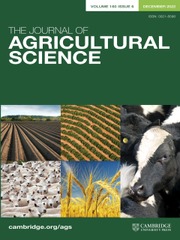No CrossRef data available.
Article contents
Agronomic performance of Arabica coffee cultivars for the low-altitude region
Published online by Cambridge University Press: 15 November 2024
Abstract
Temperature increase may cause some regions in the world to become marginal or unsuitable for Arabica coffee cultivation, due to either heat and/or marked water deficit. The feasibility of sustainable coffee production in these regions promotes good opportunity of income and value addition for rural producers within an expanding market. This study aimed to identify short-stature Arabica coffee cultivars with the best agronomic and qualitative performance in a low-altitude region. The experiment was located in northeastern São Paulo state, Brazil, at 565 m above sea level. During the experimental period (2014–2018) the average annual and November temperatures were 23.0 and 24.3°C, respectively, with an average annual water deficit of 109 mm. The experimental design was randomized blocks, with four replicates, and the treatments consisted of 17 short-stature cultivars. The cultivars Catuaí Amarelo IAC 62, Catuaí Vermelho IAC 99, IAC Ouro Amarelo, Obatã IAC 1669-20, Obatã IAC 4739, Tupi IAC 1699-33, IAC 125 RN and IPR 100 stood out in terms of yield, reaching approximately 50 bags/ha. The appropriate choice of Arabica coffee cultivar in a low-altitude region may result in yield increment of up to 74%. The cultivars Catuaí Vermelho IAC 99, Tupi IAC 1699-33 and IAC 125 RN produced grains with the best quality and highest hundred-grain weight, processing yield and percentage of grains retained on sieve 17. Therefore, it is possible for an Arabica coffee cultivar to have high yield and high grain and beverage quality in a low-altitude region, promoting production alternatives for farmers.
- Type
- Crops and Soils Research Paper
- Information
- Copyright
- Copyright © The Author(s), 2024. Published by Cambridge University Press



